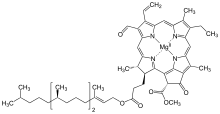Chlorophyll f
Chlorophyll f is a type form of chlorophyll that absorbs further in the red (infrared light) than other chlorophylls.[2][3] In 2010, it was reported from stromatolites from Western Australia's Shark Bay.[4]
 | |
| Names | |
|---|---|
| IUPAC name
[methyl 14-ethyl-8-formyl-4,13,18-trimethyl-20-oxo-3-{3-oxo-3-[(3,7,11,15-tetramethylhexadec-2-en-1-yl)oxy]propyl}-9-vinylphorbine-21-carboxylatato(2−)-κ4N23,N24,N25,N26]magnesium | |
| Identifiers | |
3D model (JSmol) |
|
| ChEBI | |
PubChem CID |
|
| |
| |
| Properties | |
| C55H70O6N4Mg[1] | |
| Molar mass | 907.4725 g/mol |
Except where otherwise noted, data are given for materials in their standard state (at 25 °C [77 °F], 100 kPa). | |
| Infobox references | |
The finding was made by scientists at the University of Sydney led by Professor Min Chen, and is the first discovery of a new form of chlorophyll in 60 years.[4] However, the function of chlorophyll f in photosynthetic reactions is uncertain and the ecological distribution of chlorophyll f remains unknown. Chlorophyll f has been shown to support some of the roles in photosynthetic reactions, in both the energy transfer and in the charge separation processes.[5][6][7]
Based on NMR data, optical and mass spectra and density functional theory (DFT) simulation, it is confirmed to have a structure of C55H70O6N4Mg or [2-formyl]-chlorophyll a.[1][2]
References
- Willows, Robert D.; Li, Yaqiong; Scheer, Hugo; Chen, Min (15 March 2013). "Structure of chlorophyll f". Organic Letters. 15 (7): 1588–1590. doi:10.1021/ol400327j. PMID 23496297.
- Chen, M. .; Schliep, M. .; Willows, R. D.; Cai, Z. -L.; Neilan, B. A.; Scheer, H. . (2010). "A Red-Shifted Chlorophyll". Science. 329 (5997): 1318–1319. Bibcode:2010Sci...329.1318C. doi:10.1126/science.1191127. PMID 20724585.
- Ferris Jabr (August 19, 2010). "A New Form of Chlorophyll?". Scientific American. Retrieved 2010-09-07.
- "Australian scientists discover first new chlorophyll in 60 years". University of Sydney. 20 August 2010.
- Nürnberg, Dennis J.; Morton, Jennifer; Santabarbara, Stefano; et al. (2018). "Photochemistry beyond the red limit in chlorophyll f–containing photosystems". Science. 360 (6394): 1210–1213. Bibcode:2018Sci...360.1210N. doi:10.1126/science.aar8313. ISSN 0036-8075. OCLC 7735829001. PMID 29903971.
- Zamzam, Noura; Kaucikas, Marius; Nürnberg, Dennis J.; et al. (2019). "Femtosecond infrared spectroscopy of chlorophyll f-containing photosystem I". Physical Chemistry Chemical Physics. 21 (3): 1224–1234. Bibcode:2019PCCP...21.1224Z. doi:10.1039/C8CP05627G. hdl:10044/1/66728. ISSN 1463-9076. OCLC 7943211172. PMID 30566126.
- Dunning, Hayley (June 14, 2018). "New type of photosynthesis discovered". Phys.org. Retrieved 2019-03-25.